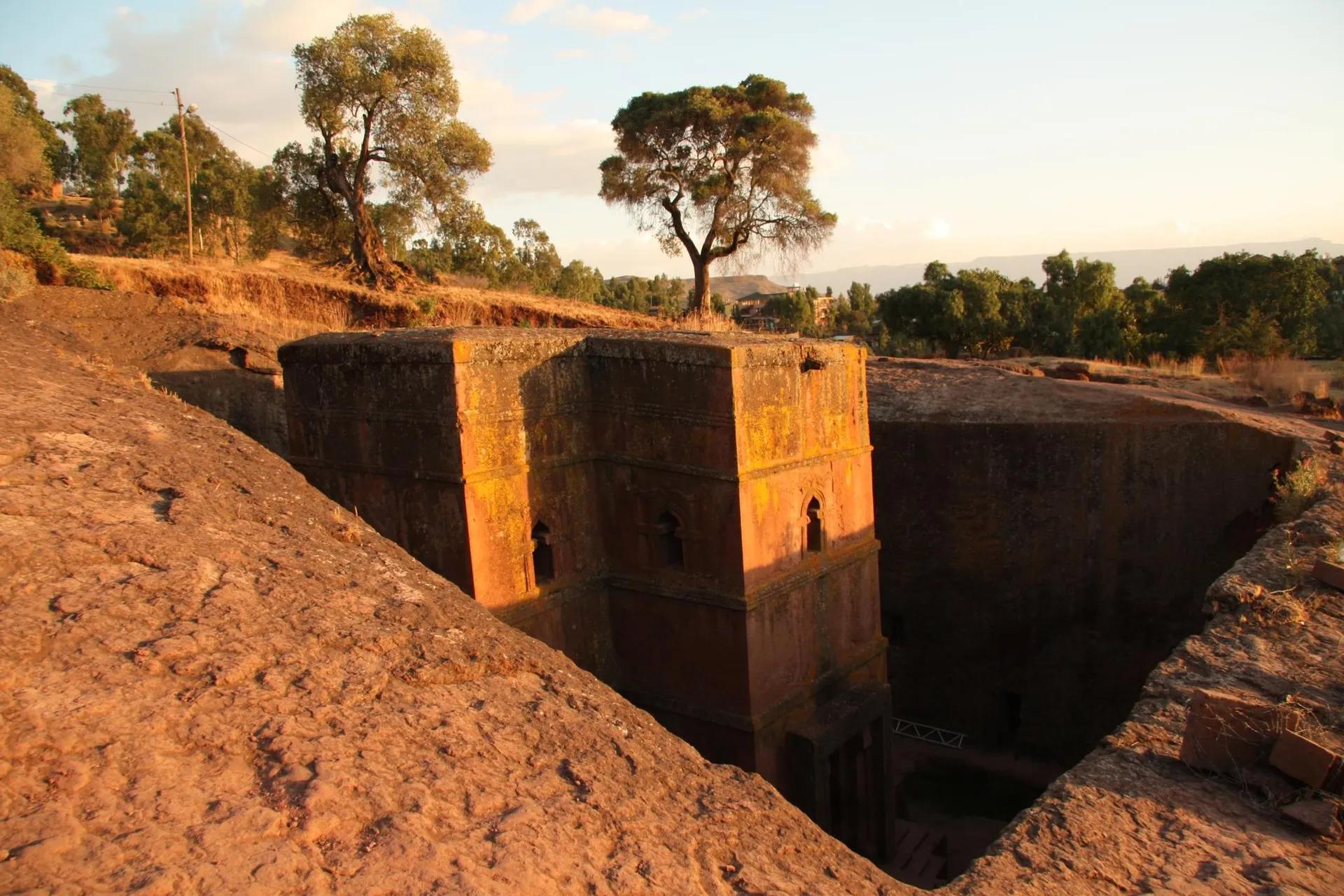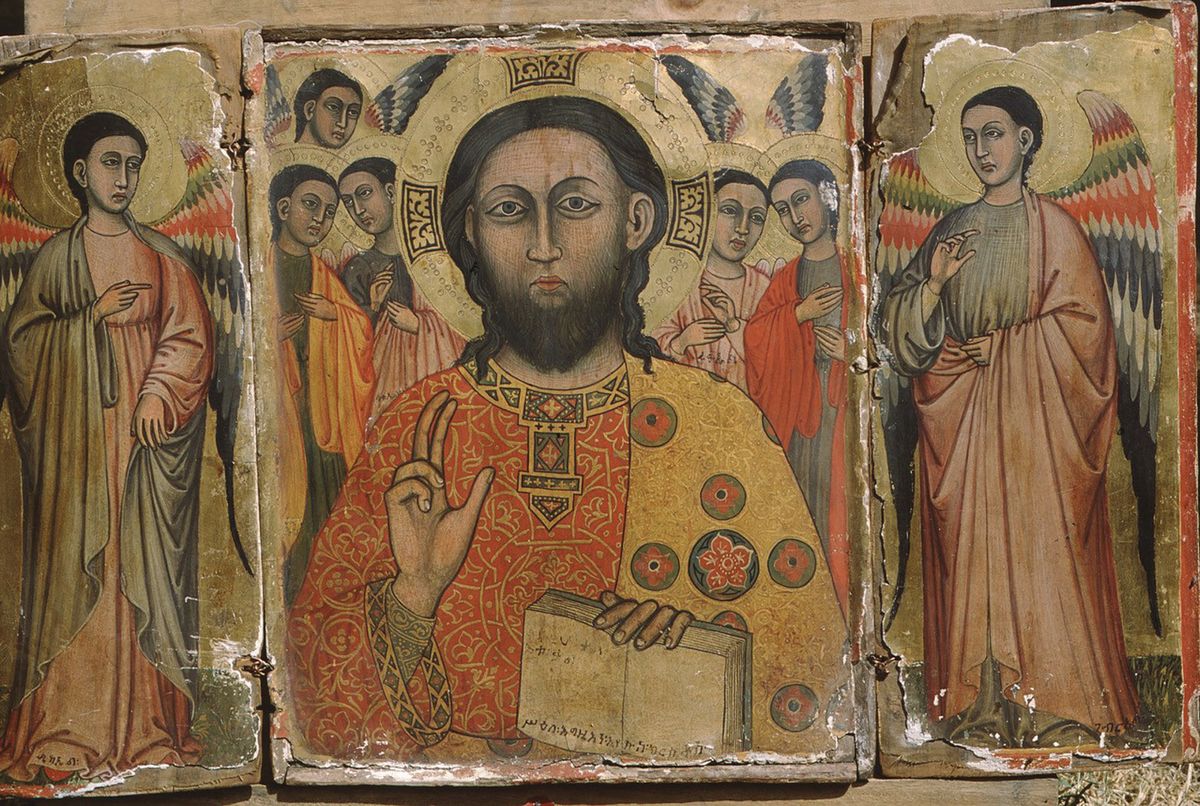Ethiopia’s oldest icon may not have come from Byzantium, but was instead painted in eastern Africa by a master from Siena who travelled there as early as the 14th century. This revolutionary theory is put forward by the French specialist Jacques Mercier in his new book Art of Ethiopia. If correct, it would represent one of the earliest important direct artistic links between Europe and sub-Saharan Africa after Roman times.
The triptych, Image of Our Lord Jesus Christ, belongs to the Church of the Saviour of the World. This church is in the hamlet of Gurji near the monastery of Tadbaba Maryam (Tabernacle of Mary), which is set in an extremely remote spot in the mountains of Wello province in northern Ethiopia. It is a miraculous icon and is displayed only once a year and occasionally to aid women who are finding it difficult to conceive.
When the icon was first seen by the British art historian Diana Spencer in 1970 she had made a hazardous five-day journey by mule, climbing from the nearest road. The monastery is at an altitude of around 3,400m, at the summit of a volcanic table mountain. She was apparently only the third European to have reached it in 500 years. Although Ethiopia’s road network has expanded since then, by the time of Mercier’s trip it was still a full day’s journey by mule.
The triptych (90cm wide when open) depicts the blessing Christ with five archangels in the central panel. The two wings have standing figures of the archangels Michael and Gabriel. Seven archangels are common in Ethiopian iconography, although in European art there are often fewer.
At the bottom of the central panel, inscribed on the book, is a slightly later inscription identifying the figure as Christ. The inscription is written in Ge’ez, the ancient liturgical language of the Ethiopian Orthodox Church.

The Tadbaba Maryam monastery, which holds the rarely seen icon, is extremely difficult to reach: it sits on top of a plateau in the middle distance in this photo © Jacques Mercier
Until now the triptych has been assumed to have been made in Byzantium, in south-east Europe, possibly in the mid 1400s. Mercier, however, believes it to be older. He dates it to 1370-98, which would make it the earliest surviving panel painting in Ethopia.
Mercier calls attention to close parallels with the art of Siena. The modelling of the faces is done with “a network of thin, intersecting lines against a background of broad flat tints”, a fine-hatching technique “quite common in 14th-century Sienese painting”. The punched golden haloes also represent “an Italian practice”.
Although the drapery of the angels appears more rigid than that of Sienese artists, Mercier points out that “the decoration of Christ’s garments is admirably executed”. The intersecting circles on the garments are similar to the patterning found on Ethiopian processional crosses of the period. Using gold on the garments suggests to Mercier that the artist came from a goldsmithing background.
The miraculous icon is displayed only once a year and occasionally when woman are finding it difficult to conceive
The triptych seems to represent both Italian and Ethiopian iconography and techniques. Appealing to Ethiopian taste, Mercier concludes that it was painted in Ethiopia, probably by a Sienese goldsmith attached to the royal court of the Ethiopian emperors.
So how did a Sienese artist or goldsmith end up in Ethiopia, an arduous journey of more than 5,000km? Mercier points to the lure of Prester John, the legendary Christian ruler from the Orient who was then believed to live in Ethiopia. Prester John was thought to possess the world’s greatest collection of gold, silver and precious stones—an enticing attraction for an adventurous western European goldsmith.
Mercier’s study of Image of Our Lord Jesus Christ upturns previous research. In 2020 the German historian Verena Krebs published the icon as a European work imported into Ethiopia—either made in the Black Sea coastal area to the east of the Balkans or in a Cretan workshop. However, she noted that “the garment of Jesus” and its drapery colouring is unusual for Byzantium and is “hard to place in time and origin”. She tentatively dated the work, or at least the triptych wings, to the mid 15th century.
After we contacted Krebs last month, she now accepts the possible Italian stylistic links—and agrees that it could well be earlier than she had previously thought. However, unlike Mercier, she doubts that it was painted in Ethiopia; she believes that it may have been taken there by an Ethiopian diplomatic mission that visited Venice in 1402. Krebs agrees that “further research is needed”.
Wherever the triptych was created, it is unclear how it reached the remote monastery of Tadbaba Maryam, although it was most likely commissioned by an Ethiopian emperor, possibly for another church.

Lalibela, which was temporarily captured by the Tigray People’s Liberation Front in mid December, is famous for its rock-hewn monolithic churches such as the Church of Saint George Photo: Alastair Rae
Wello province is currently part of the area which is being fought over in a civil war between Tigrayan rebels in the north and government forces. The historic religious centre of Lalibela, which lies only 80km to the north of Tadbaba Maryam as the crow flies (but is a very much longer and difficult journey), was temporarily captured by the forces of the Tigray People’s Liberation Front in mid-December.
However, the Church of the Saviour of the World is so remote that it has a good chance of surviving unscathed. The plateau’s very isolation, together with the determination of the monks to preserve their ancient treasures, will hopefully safeguard this miraculous icon.
• The Art of Ethiopia: from the Origins to the Golden Century (330-1527), by Jacques Mercier, is published by Editions Place des Victoires, Paris


